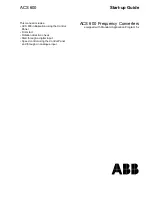
8
05.01
8.5 Start inhibit in the drive modules/safe standstill
8-255
©
Siemens AG 2012 All Rights Reserved
SIMODRIVE 611 Configuration Manual (PJU) – 02/2012 Edition
Notice
The start inhibit relay has pick–up and drop–out delay times of
max. 40 ms. The external wiring must be connected to terminals AS1/AS2 so
that it is short–circuit proof.
One side of the excitation coil of the safety relay is connected to the grounded
electronics chassis (PELV circuit according to DIN VDE 0160). When supplying
the excitation coil (relay coil) from an external 24 V power supply, its negative
pole must be connected to ground potential. The external 24 V power supply
must fulfill the requirements for a PELV circuit in compliance with DIN VDE
0160.
Table 8-1
Technical data of the safety relay
Termi-
nal
Designation
Description
Type
1)
Section
AS1
2)
Contact 1
Feedback signal
contact, relay
NC
30 V DC/max. 2 A
AS2
2)
Contact 2
Start inhibit
250 V AC/max. 1 A
3)
663
Control input
”start inhibit”
Nominal resist-
ance of the ex-
citation coil
600
Ω
... 1000
Ω
I
21 – 30 V DC
Max. switching frequency:
6/min
Electrical lifetime: min.
100.000 operating cycles
Mechanical lifetime: 10 mil-
lion operating cycles
9
Enable voltage
FR+ (internal)
O
+ 24 V
19
Reference
FR– (external)
O
Chassis ground
1) I = input; O = output; NC = NC contact
2) When the AS1/AS2 contacts are connected in series a contact resistance of
approx. 0.20 Ohm must be taken into consideration over the lifetime of the contacts.
For a 24 V switching voltage, due to the non–linear contact characteristics, from
experience, five contacts can be simply connected in series without encountering
any problems.
3) In accordance with EN 60204–1 (machine safety), control transformers must be used
for AC control voltages.
!
Warning
Only qualified personnel may install and commission the ”safe standstill”
function.
All of the external safety–relevant cables, e.g. control cable for the safety relay,
feedback signal contacts, must be routed so that they are protected, e.g. using
cable ducts. The possibility of short–circuits and cross–circuits must be
excluded.
8 Important Circuit Information
05.08
















































